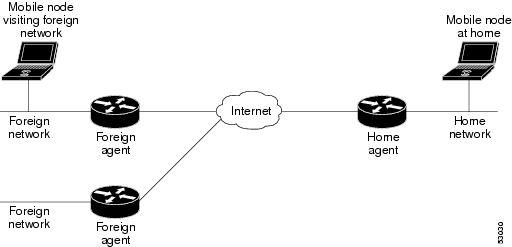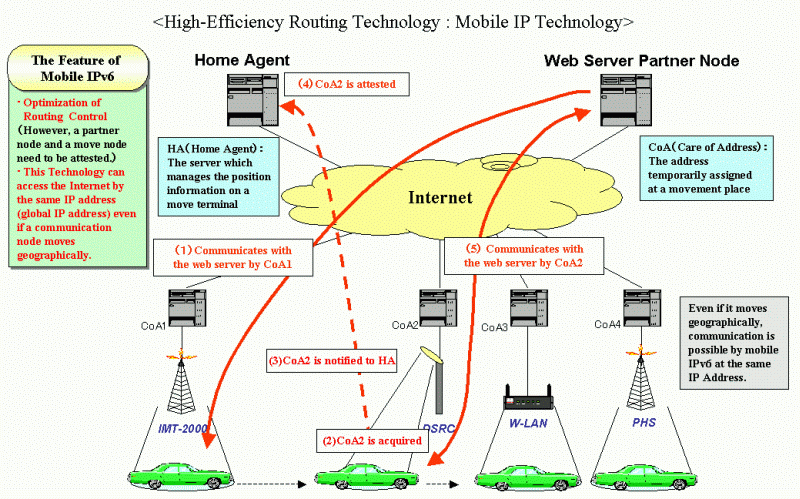- Subscribe to RSS Feed
- Mark as New
- Mark as Read
- Bookmark
- Subscribe
- Printer Friendly Page
- Report Inappropriate Content
- Subscribe to RSS Feed
- Mark as New
- Mark as Read
- Bookmark
- Subscribe
- Printer Friendly Page
- Report Inappropriate Content
05-09-2014 12:23 AM - edited 11-18-2020 03:07 AM
- Introduction
- More Information
- Mobile IP (or MIP)
- Topology
- Mobility and OSI
- Mobile IP: Components
- Protocol Concepts
- Changes in IPv6 for Mobile IPv6
- Question
- Reference
Introduction
The number of wireless devices for voice or data is projected to surpass the number of fixed devices. Mobile data communication will likely emerge as the technology supporting most communication including voice and video.
More Information
Mobile data communication will be pervasive in cellular systems such as 3G and in wireless LAN such as 802.11, and will extend into satellite communication.
For communications devices, users expect mobility to be more than just the ability to move. The goal of communications mobility is for a device to be fully operable while it is moving. Mobile telephony has set a standard that mobile computing devices need to live up to. These devices need to be fully functional whenever and wherever they are operated.
Mobile IP (or MIP)
This document is an attempt to explain in high level about Mobile IP .
Mobile IP (or MIP) is an Internet Engineering Task Force (IETF) standard communications protocol that is designed to allow mobile device users to move from one network to another while maintaining a permanent IP address
- A standard that allows users with mobile devices whose IP addresses are associated with one network to stay connected when moving to a network with a different IP address.
- Mobility functions of Mobile IP are performed at the network layer rather than the physical layer and hence the mobile device can span different types of wireless and wire line networks while maintaining connections and ongoing applications .
Lets first look at the difference between Simple IP and Mobile IP .
- For simple IP protocol, a wireless device must obtain a new IP address (and lose existing connections) every time it changes its point of attachment.
- That is, moving from the coverage area of one PDSN to another PDSN constitutes a change in packet data session because a new IP address is assigned by the new PDSN. A packet data session and a PPP session are concurrent in simple IP, that is, the existence of the packet data session is dependent upon a PPP session.
However ,
- For mobile IP protocol, a wireless device is allowed to maintain the same IP address as it moves from link to link (network to network) and preserve existing connections during moves.
- That is, the packet data session can exist through several changes of the PPP session. The mobile IP allows the PPP session to be terminated and reestablished without the termination of the packet data session. A packet data session can span several PDSNs as long as the user continuously maintains mobility bindings at the Home Agent (the IP address is persistent).
Lets understand the same with an analogy of Postal Service.
Topology

Mail was sent to you by placing a letter (the packet payload) in an envelope addressed to you (IP header). The letter arrives at your local post office and is routed to you at your Home Address, .
Now when you relocate to a new address , you tell the local post office (Home Agent) to forward packets all the letters to your new location (Care-of Address [CoA]).
Now, when a letter addressed to your Home Address arrives at your local post office, it can now be readdressed (tunneled) to your new location (CoA).
The letter then arrives at the post office that services your new location (Foreign Agent [FA]) and is delivered to you at your new location (CoA).
This mail delivery is done with no effort (and usually even knowledge) by the original sender of the letter (Correspondent Node [CN]).
Mobility and OSI
At the bottom of OSI is the access technology, where many existing mobility protocols currently reside .
The layers at the top are usually controlled by software applications, where no standard mobility protocol exists. For ex : Instant-messaging clients , Email clients .
In the middle, the network or IP layer is rapidly proving itself to be the ideal place for link- and application-independent services like mobility.
Layer 3 ( the network layer) / IP are ideal candidates for supporting full mobility protocols.As you know IP is supported on a wide range of wired and wireless links, and is supported by many applications.
IP mobility allows all IP-enabled applications, whether they use Transmission Control Protocol (TCP), User Datagram Protocol (UDP), or any other transport protocol, to seamlessly inherit full mobility across a diverse range of access link types.
Users can roam from fixed Ethernet to wireless Ethernet to cellular, only noticing the degradation in speed and latency. The user does not need to restart applications, interrupt sessions, or reboot .

Mobile IP: Components
Mobile Node (MN)
A host or router that changes its point of attachment from one network or subnetwork to another . Mobility Node can be any IP device running a Mobile IP client stack; Mobile
Nodes can be anything from smart phones to PDAs and laptops to network devices like routers . It does its own move detection and thus must be able to detect logical movement and learn its current location. Logical movement is not simply the change in the access device, but a change in the subnet associated with the access link.
When a Mobile Node decides to hand over, it must signal this change to the Home Agent, typically through a Foreign Agent .
Home Address
Mobile Node's IP address can be called as its Home Address. The Home Address is allocated out of the Home Network, which is attached to the Home Agent. The Home Address is either statically assigned or dynamically allocated during the Mobile IP registration process.
Home Agent (HA)
The Home Agent is a router capable of processing Mobile IP routing updates, called registrations, and forwarding traffic to the Mobile Node through dynamically created tunnels.
Care-of Address (COA)
The CoA is the new IP address which is valid and routable at the Mobile Node's current point of attachment in the Foreign Network . The Mobile Node informs the Home Agent of this CoA during the Mobile IP registration process .
Foreign Agent (FA)
FA stores information about mobile nodes visiting its network. Foreign agents also advertise care-of addresses, which are used by Mobile IP. If there is no foreign agent in the host network, the mobile device has to take care of getting an address and advertising that address by its own means. The FA acts as a router on a Mobile Nodes visited network which provides routing services to the MN while registered.

Protocol Concepts
There are four basic requirements for a mobility :
Location discovery
We saw that two types of networks/location exist: the Home Network and the Foreign (Visited) Network. The type of network to which the Mobile Node is attached is central to the protocol, because each protocol results in a different type of Mobile IP handover and requires different Mobile IP signaling. The location is determined by examining Mobile IP agent advertisements, if one is received, or by examining the allocated Colocated CoA.
Move detection
Mobile Nodes are constantly on move and hence are always engaged in process of move detection which the act of monitoring changes in paths available into the network .Whenever movement is detected, Mobile IP uses its Mobile IP handover
policy algorithm to evaluate all available candidate routes and determine whether a change in routing is necessary ( Mobile IP handover) .
Update signaling
If Mobile IP handover has been initiated, the Mobile Node determines
the type of Mobile IP signaling necessary based on its previous and new location type. This is in the form of a Registration Request (RRQ) or a Deregistration Request.
Path (re)establishment
For successful Mobile IP registrations, a tunnel is established between the CoA and Home Agent .At this point, the Mobile Node cycles back to the move detection state, and the process begins again.

Changes in IPv6 for Mobile IPv6
A set of mobility options to include in mobility messages
A new Home Address option for the Destination Options header
A new Type 2 Routing header
New Internet Control Message Protocol for IPv6 (ICMPv6) messages to discover the set of home agents and to obtain the prefix of the home link
Changes to router discovery messages and options and additional Neighbor Discovery options
Foreign Agents are no longer needed .
In the next article we will discuss the basics of PMIPv6 .
Question
Q. What type of Dynamic Tunnel is created between FA and HA , FA and COA? Why GTP based Tunnel mechanism which is used in PMIPV6 (Network based Mobility) cannot be used in this L3 - MIP Network roaming scenario?
A. The default tunnel mode is IP Encapsulation within IP Encapsulation. Optionally, GRE and minimal encapsulation within IP may be used.
https://www.ietf.org/rfc/rfc2002.txt (Refer to - Registration Lifetime ). I believe GTP and PMIPv6 tunneling was meant for 3GPP networks and didn't work well with non 3GPP networks .
Reference
- 1000
- 1040
- 1100
- 1100_ap
- 1100_lap
- 1130_AG
- 1130_ap
- 1130_lap
- 1140
- 1140_ap
- 1140_lap
- 1200
- 1200_ap
- 1200_lap
- 1230_AG
- 1230_ap
- 1230_lap
- 1240_AG
- 1240_ap
- 1240_lap
- 1250
- 1250_ap
- 1250_lap
- 1260
- 1300
- 1300_bridge
- 1400
- 1400_bridge
- 1500
- 1500_map
- 1520
- 1550
- 1600
- 2000_wlc
- 2100_wlc
- 2500
- 2600
- 3300_Series_Mobility_Services_Engine
- 340_ap
- 3500
- 350_ap
- 3600
- 3750_wlc
- 3850
- 4400_wlc
- 4400_wlc ldap
- 500_lap
- 5500
- 5500_wlc
- 5505
- 5508
- 5700
- 5760
- 600_Series OfficeExtend_AP
- 7900_ip_phone
- 802.11a
- 802.11b
- 802.11g
- 802.1x
- 8500
- aaa
- active_directory
- air_cb21ag
- aironet
- aironet_antennas
- ap
- autonomous
- catalyst_3850
- cisco_5760_wlc
- cisco_prime_ncs
- converged_access
- eap
- eap_fast
- external_server
- hwic_ap
- lap
- leap
- lo
- lwapp
- ncs
- ngwc
- peap
- prime
- Prime_Network_Control_System
- radio
- radius
- roaming
- ssid
- tacacs
- virtual_wireless_controller
- wcs
- wgb
- wireless_lan_controller
- wireless_lan_controllers
- wism
- wlan
- wlc
- wlc_5500
- wlc_5508
- wlcm
- wlse
- wlsm
- wpa
- Mark as Read
- Mark as New
- Bookmark
- Permalink
- Report Inappropriate Content
Hi Sharath,
COA reminds me of Radius COA, What type of Dynamic Tunnel is created between FA and HA , FA and COA ?
Why GTP based Tunnel mechanism which is used in PMIPV6 (Network based Mobility) cannot be used in this L3 - MIP Network roaming scenario ?
- AKRAM
- Mark as Read
- Mark as New
- Bookmark
- Permalink
- Report Inappropriate Content
Hi Akram ,
The default tunnel mode is IP Encapsulation within IP Encapsulation. Optionally, GRE and minimal encapsulation within IP may be used.
https://www.ietf.org/rfc/rfc2002.txt (Refer to - Registration Lifetime ).
I am no expert in this area , but I believe GTP and PMIPv6 tunneling was meant for 3GPP networks and didn't work well with non 3GPP networks .
Sharath K.P.
Find answers to your questions by entering keywords or phrases in the Search bar above. New here? Use these resources to familiarize yourself with the community: